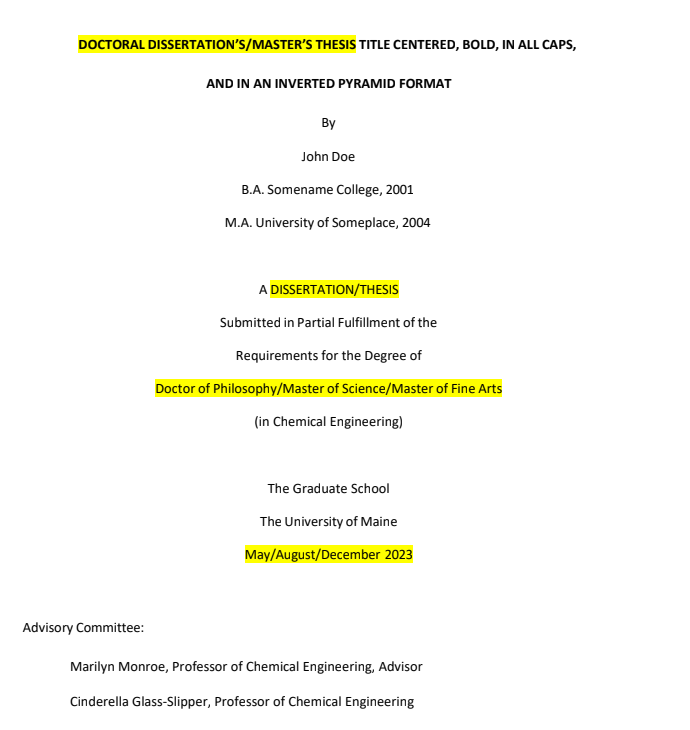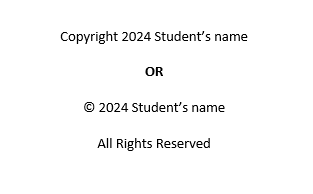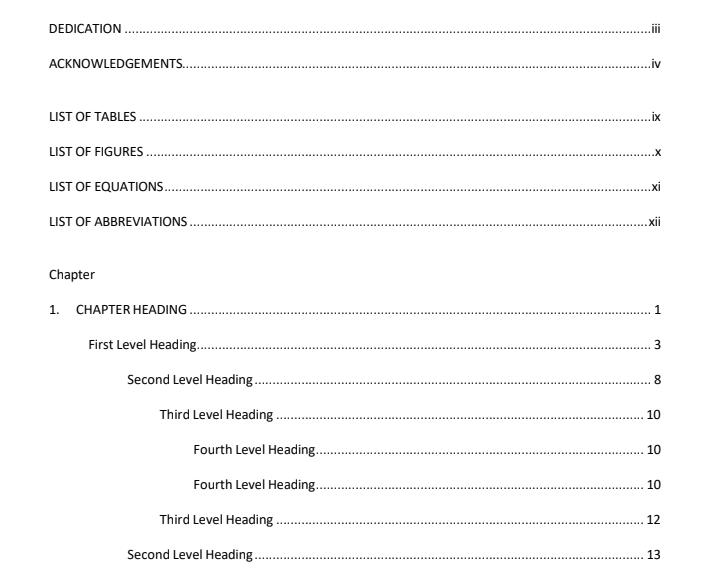thesis & Dissertation Resources
The policies, format, and style requirements in this manual reflect The University of Maine’s standards for scholarship and quality of work. Whenever there is a reference to the word “thesis,” we are also referring to a dissertation or a master project.
The guidelines are reviewed and updated periodically to reflect the dynamic nature of scholarship. It is the student’s responsibility to follow and meet the requirements when writing a dissertation, thesis, or master’s project.
Previously published dissertations should not be used as examples. Students who do not follow the formatting specifications will not be eligible for conferral of their degree and will need to apply for the next available degree period after corrections are made.
If clarifications are needed, students should consult with the Graduate School.
Thesis & Dissertation Committee
The thesis will be reviewed by the thesis committee for content and research accuracy. The role of the thesis committee is to guide the student through the research and writing process by providing suggestions and feedback as to the contents, direction, timeline, style, citations, and other aspects of the research.
The thesis draft submitted to the Graduate School should be a product of this negotiation between the student and the committee. Even though the committee’s recommendations may have a significant impact on the thesis’ final form, it is the student who is ultimately responsible for the content and style of the thesis.
Graduate faculty are appointed by the Graduate School upon the recommendation of the appropriate department.
Upon the recommendation of their committee, students may follow the style manual of a leading journal or of a professional association for the use of field-specific terminology, formulas, signs, and other features of the text, as well as formats for documenting sources. The format requirements of the graduate school must be satisfied first, even if they depart from the style manual that has been adopted. Papers that have been published in a journal or other publication and are included in the thesis must be re-formatted to adhere to these guidelines.
Recommended Fonts & Point Size
Page Size: Standard 8.5×11 inches
Margins: 1 inch for all margins
Spacing: Double spacing except for degree information on the Abstract & Block quotations, footnotes, and bibliographies: single spacing within each entry but double-spacing between each entry
Pagination: Check pagination carefully. Account for all pages.
The Title Page is counted as page “i” but the number does not appear on the page.
Excluding the Abstract, all other pages of the thesis are numbered including display (optional) pages.
The preliminary pages, starting with the Copyright Notice (if included), are marked by lowercase Roman numerals (ii, iii, iv, v, vi, etc.).
Beginning with the first page of the text, all pages including the appendices, are numbered consecutively with Arabic numerals (1, 2, 3, 4, etc.). The following table displays the proper pagination of all parts of the thesis and which pages should be listed on the Table of Contents.
Page numbers appear either on the top right or bottom center of the page. Page numbers need not fall within the required margins of the text, yet they must not appear closer than half an inch from the top, one inch from the right, or half an inch from the bottom edge of the page. The page numbers’ location and font style must be consistent throughout the manuscript.
parts of the manuscript
The following is a list of the required parts of the thesis in the order in which they should appear in the manuscript:
- Title Page
- Copyright Notice (optional)
- Land Acknowledgment (recommended)
- Abstract
- Dedication/Preface (optional)
- Acknowledgments (optional)
- Table of Contents
- List of Tables (if any)
- List of Figures (if any)
- List of Abbreviations, Plates, Equations, Theorems, Symbols, Definitions, etc. (if any)
- Text of the Manuscript
- Captions (if any)
- Endnotes or Footnotes (if any)
- Bibliography (or References, or Works Cited)
- Appendix or Appendices (if any)
- Biography of the Author
Title
The Title Page is the first page of the manuscript. It is considered page “i”, but the number does not appear on the page.
The following should be CENTERED included on the title page:
- Title of thesis in ALL CAPS, bold, and inverted pyramid format
- The student’s full name as it appears in University records
- Previous degree(s) earned
- A statement of fulfilling requirements for the degree sought
- Institution name: The Graduate School
- Institution name: The University of Maine
- The month and year of the student’s graduation date
- The advisory committee members (single space & left justify if necessary to keep on one page)

Note: The first name(s) listed is the Advisor’s (or Co-Advisors’) and their title(s) followed by the names and titles of the remaining committee members. Do not include degrees such as “Dr.” on the title page. This page is to acknowledge committee members exclusively, “Readers” are recognized in the Acknowledgements.
Copyright & Land Acknowledgement
Unless the manuscript has been formally registered (copyrighted), this page is optional. If the student chooses to acknowledge his or her rights as an author, a copyright notice should be placed as the sole text on a page immediately following the title page.
The page is numbered but a listing does not appear on the Table of Contents. The copyright notice is centered vertically and horizontally within the margins. Unless there are special terms under which the work has been copyrighted the text of the notice may take either of the two forms below.
Consider Creative Commons as an option for obtaining copyright.
Use of Third-Party Content: For additional information regarding the use of copyrighted materials, please visit the U.S. Copyright Office website at http://www.copyright.gov

University of Maine graduate students are expected to include a statement in their final thesis or dissertation that acknowledges that their graduate study has taken place on the ancestral lands of the Wabanaki Tribal Nations. The Graduate School acting through the Graduate Board recommends two nonexclusive options for a tribal land acknowledgement. The first option is to include the statement that was developed by the President’s Council on Diversity, Equity, and Inclusion and adopted by the University of Maine in the acknowledgments section of the thesis/dissertation.
The second option, which may be especially relevant to graduate students undertaking qualitative research studies is to include a researcher positionality statement in the thesis/dissertation.
Graduate programs supporting option two should provide resources to graduate students electing this option. The development of a researcher positionality statement that acknowledges the land may be used to complement the formal University land acknowledgment statement or may be used as an alternative to this statement.
abstract
An abstract (not paginated), which is a clearly written, concise summary of the thesis, must be included in the manuscript. It describes the problem, the procedures or methods used, and the results and conclusions of the research. Since doctoral abstracts are included in Dissertation Abstracts International, it is extremely important to write accurately. Formulas, diagrams, or other illustrations are not included in the abstract.
The heading of the abstract should be centered and include:
- Title of the thesis in ALL CAPS, bold, and inverted pyramid format
- The author’s full name
- The name of the thesis advisor (including degree “Dr.”)
- A statement that the thesis is fulfilling requirements for a degree sought in a particular department
- The month and year of the student’s graduation date
dedication, preface, & acknowledgements
This page is for the author to express professional and/or personal indebtedness. Permission(s) to use previously copyrighted materials, receipt of grant funds, recognition of “readers”, etc. are acknowledged on this page. Students must be consistent with the use of the third (“the author”) or first person throughout. This page is optional, but if included, it is paginated (lowercase Roman numerals) and listed in the Table of Contents.
The use of copyrighted materials can be mentioned on the Acknowledgments page. Any copyright permission letters related to the manuscript should be included in an appendix.
table of contents

All chapter divisions and subsections must be included in the Table of Contents and labeled exactly as they appear in the text.
- The Copyright page, Abstract, and Table of Contents are NOT listed in the Table of Contents.
- All chapter divisions and subsections must be listed in the Table of Contents. Regardless of the system of headings being used for organizing the text of the manuscript (headings system or decimal system), all sub-divisions should be indented appropriately in the Table of Contents.
- One system should be used consistently throughout the entire manuscript to define the chapter divisions and subsections.
- Each Appendix must be listed by its title and page number. If there is only one Appendix, it is listed by the name “Appendix” and its title. Therefore, an Appendix “A” should not be listed unless there is an Appendix “B”.
- Leader dots must be used to connect the chapter divisions/subsection headings to their respective page numbers. A minimum of 5 leader dots between the chapter divisions/subsections and the page numbers is required (i.e. the text of the headings should not extend into the area where the page numbers are placed).
- The Biography of the Author page is the LAST page of the thesis.
Learn how to align page numbers in the Table of Contents
How to right justify page numbers in the Table of Contents & lists
text, tables, figures, & captions
The text’s body font must also be used in headers, page numbers, and footnotes. Exceptions are made only for tables and figures created with different software and inserted into the document.
Tables: A TABLE is a columnar arrangement of information organized to save space and convey relationships at a glance.
Figures: A FIGURE is a graphic illustration (chart, graph, diagram, photo, map, or plate). Figures may be professionally prepared or drawn by the author. In either case, they must be of letter-quality print.
Figures & Tables must be placed as close as possible to their first mention in the text. If a table or figure with the caption is larger than 2/3 of a page, it must be moved to a separate page. Tables and figures referred to in the text may not be placed at the end of the chapter or the end of the dissertation.
Captions must be on the same page as the figure on the table. If the table exceeds one page, the caption should go on the first page and the second page will be labeled as table/figure continued.
Landscape orientation figures and tables must be oriented as such by inserting a section break and rotating the page. This makes the figure/table readable in digital format.
The List of Tables and the List of Figures (if any) appear as individual pages.
A List of Tables/Figures is necessary even if there is only one table or figure.
If the text of the manuscript contains a consistent set of theorems, symbols, abbreviations, or definitions, those should be listed in a List of Theorems, Symbols, Abbreviations, or Definitions respectively. These lists are included in the Table of Contents.
- Tables/figures must be numbered and titled. Further explanatory information provided in a caption that is not part of the title should not appear on the List of Tables/Figures.
- The tables/figures are numbered separately from each other. Each group is numbered consecutively throughout the entire manuscript or by chapter using a decimal numbering system (e.g., the third table in chapter two will be Table 2.3., and the third figure in chapter two will be Figure 2.3.). The same system should be used for numbering figures AND tables.
- All tables/figures must fit into the required page margins.
- The title and caption of the table/figure are part of the text and must be the same font size and style of the body of the manuscript. It is acceptable for the font within the table/figure to be as small as 9-point font.
- Tables/figures must be placed in the text as they are mentioned. If the Table/Figure is larger than one-half of the page it must be placed on a page of its own.
- Tables/figures that extend onto a second page must be labeled “Table/Figure # Continued”
- Appendix tables/figures must be numbered separately (e.g., the third table in Appendix A would be numbered Table A.3.) and must be included in the List of Tables.
- Photographs must be originals or high-quality reproductions. All photographs must have captions.
endnotes & footnotes
Footnotes appear at the bottom of the page or at the end of a chapter; endnotes appear on a separate page at the end of the text before the Bibliography. The notes are numbered consecutively throughout the text by a raised Arabic numeral (e.g. 12) which corresponds to the number of the note at the bottom of the page or at the end of the text.
Bibliography, References, Works Cited, & Appendix
The full publication information of all sources cited in the manuscript should be provided in a Bibliography.
The layout as well as the title of the Bibliography (Works Cited, References) depends on the style manual that is being followed. If the thesis has been compiled from a series of articles, the references must still be combined into a single, comprehensive Bibliography.
Students may choose to include references at the end of each chapter; however, they are considered part of the text, therefore they need to be formatted as such and cannot replace the comprehensive Bibliography.
The appendices contain material that is pertinent to the text, but not directly included (raw data, questionnaires, consent forms, etc.).
If there is only one appendix, it is called “APPENDIX” (not Appendix A) and is given a title.
If there are two or more appendices, each is labeled “A”, “B”, “C” etc., given a title, and entered on a new page. The titles of the appendices are listed in the Table of Contents.
NOTE: If the data in your Appendix or Appendices goes on for many pages, it is acceptable to upload a separate file in “supplemental material.” In such a case, the Appendix is listed on the Table of Contents by title with leader dots followed by “Supplemental Material” instead of the page number.
Pagination from the text must continue throughout the Appendices. If display pages are used, they are counted in the pagination. The margins and font size used in the appendices should be the same as in the text. A reduced copy of the material may be included in an appendix; however, the title and caption of such material must be the same font size and style as the manuscript.
biography of the author
A biography of the candidate must be included in the thesis.
For privacy reasons, students may exclude personal information. In such a case, the only line on the biography will read:
“[Name/Pronoun] is/are a candidate for the [DEGREE TYPE] degree in [FIELD OF STUDY] from The University of Maine in [Month] [Year].”
If a student chooses to include a biography, it must be written in the third person. The absolute last line MUST read:
“[Name/Pronoun] is/are a candidate for the [DEGREE TYPE] degree in [FIELD OF STUDY] from The University of Maine in [Month] [Year].”


